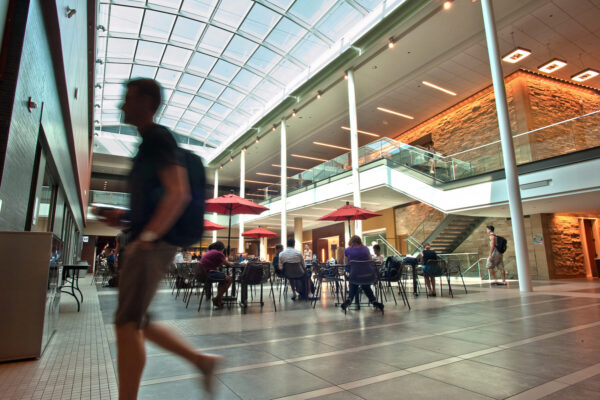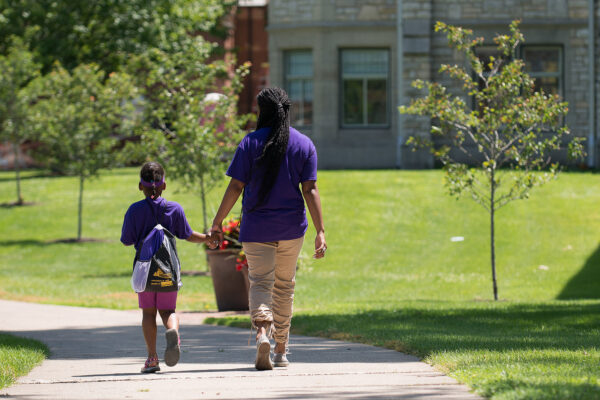By Elizabeth (Beth) J. Stroble
At Webster University, it is natural for us to prize the diversity of our university community. The university was founded in 1915 as a private nonprofit institution, one of the first baccalaureate colleges west of the Mississippi for young women. During the past century, Webster transitioned from Catholic origins to lay governance and independence; opened admissions to men; and took education to students on military installations, U.S. metropolitan and corporate locations, and American-style residential campuses in Europe, Asia, and Africa.
The diversity of Webster’s community reflects the communities we serve. The St. Louis region, where Webster makes its home, faces many challenges. Among them, according to the St. Louis Regional Chamber, is the need to boost “greater educational attainment, inclusion and talent attraction, and entrepreneurship and innovation.” Webster’s partnerships with the Chamber, the non-profit St. Louis Graduates initiative, civic organizations, schools and colleges, and individuals committed to student success align with our historic mission of meeting an unmet need. Meeting the needs of students whose drive and ambition are great, yet whose educational readiness or financial resources lag, requires a comprehensive strategy and strong partners.
Changing Demographics Demand Inclusive Strategies
We know approximately 60 percent of incoming freshmen attending universities in the United States have permanent homes near the institution, as a university’s proximity to “home” is increasingly becoming an important factor in college-selection decisions. While many independent colleges like Webster attract students from a broader geography, the median distance from home for an undergraduate at a private nonprofit university is 46 miles.
We also know that the characteristics of college students are changing as quickly as the demographics of our communities. National Center for Education Statistics data projections to 2023 predict faster growth among women than men and part-time rather than full-time students, and with greater racial and ethnic diversity in postsecondary education. Yet successful institutional retention and graduation rates, with resulting perceived prestige and higher rankings, too often correlate with selective admissions policies—strategies that exclude students who most need institutions to commit to their access and success. From the student perspective, the college selection decision is not always straightforward but instead may be driven as much by perceived value and further narrowed by sheer convenience and affordability.
According to a Pew study issued last year, a person with a degree will earn 40 percent more during a lifetime than a person without a degree. But without access to services that contribute to success, many of these underrepresented students—first-generation, low-income, students of color—will drop out and never finish a degree. These diminished employment outcomes are too often accompanied by high levels of debt; absent the ability to earn the income to repay their student loans, these students are also at risk of default, creating lasting effects for their credit worthiness and livelihoods.
Studies have concluded that while approximately one-third of all jobs in the United States require a degree, an increasing number of new professions also require a degree, and they are outpacing the percentage of the population that can meet those demands. In essence, we are faced with significant labor shortages in the near future. Reducing this degree attainment gap directly meets the evolving needs of our communities.
Additionally, there are personal and social benefits to obtaining a degree. Degree holders tend to live longer and have healthier lifestyles, and also report higher levels of satisfaction with their personal lives, an effect that stretches across all income levels.
Meeting the Need
Successful degree attainment doesn’t just happen on a stage with gowns and embossed pieces of paper. It’s made out of one-on-one intensive academic counseling sessions, summer days spent acclimating to the rigor of postsecondary academic work, and through enrolling a diverse class of students and making it our priority to support them every step of the way to graduation day.
These Webster data points from the National Center for Education Statistics and CollegeNet illustrate the depth of the need the strategies and partnerships and the value these efforts create:
- 81 percent of undergraduates are from households that earn less than $52,000 per year for a household of four.
- 29 percent of U. S. undergraduates self-report as an ethnic minority.
- 38 percent of U. S. undergraduates qualify for Pell Grants.
- 96 percent of incoming freshmen and transfer students receive some form of financial aid (not including loans).
- 5 percent of students finish their undergraduate program in 6 years, above the national average of 53%.
- 7 percent of graduates with a bachelor’s degree pay back their loans, as compared with 88.7 percent nationally.
- The average debt of a student is $19,500, below the national average of $25,550.
- The average alum triples their individual earning power within five years of completing a bachelor’s degree.
Successful attainment with comparatively low levels of debt and high rates of repayment requires coordinated attention on numerous levels. Incoming students must be transitioned to the rigors of postsecondary academic work through summer programs and acclimated to the social atmosphere on campus so they feel more comfortable and less isolated in a new environment. The goal of attainment must be hardwired into the campus culture, with students, faculty and staff all looking out for the community, offering support when needed and collaborating on ways to make the community more inclusive and responsive to student needs.
Closing the Gap: Retention and Attainment
We launched several programs to address these challenges. Many are offered through or coordinated with Webster’s Academic Resource Center, an integrated support center geared for student achievement. The center offers academic counseling, tutoring, writing, and assistive technology support, along with services for students with disabilities and resources for veterans. Connecting components of this system include default-prevention programs, a retention-calling program, a financial resource center, and English-language programs for Webster’s international students.
As part of our effort to enhance student success, the Resource Center created both the Transitions and the Transitions Academic Prep (TAP) programs, which helps students learn successful college behaviors and build a personalized roadmap to help them thrive.
Transitions was founded in 2009 for students admitted with conditions typically assessed through at-risk indicators such as ACT scores or grade point averages, and who have completed 30 or fewer postsecondary semester hours. While the program only admits based on academic conditions, the Transitions alumni tend to self-identify as an ethnic minority, the first-to-attend college in an immediate family, or from a household that earns less than the national average income. The program provides academic counseling and peer tutoring, learning strategies, organization skills, and time management. Required weekly sessions establish close relationships with peers and trusted adults.
Webster expanded Transitions with TAP in 2011, a 10-day residential credit-bearing summer program. Students take free courses to build writing skills and develop study habits. Sessions include plagiarism prevention, documentation, essay writing skills, diversity and inclusion topics, library resources, and time management. TAP participants also meet faculty and staff from various departments, take departmental tours, and explore issues about socially acclimating to a campus environment.
Prior to implementing Transitions, Webster experienced a gap of 6 percent between the retention rates for conditionally admitted students versus those without conditions. As of 2016, the trend reversed, with retention rate for transition participants at nearly two percent higher than non-Transition students. Preliminary indicators also suggest TAP and Transitions students are graduating at a higher rate than non-conditional students. Last year, nearly 13 percent of all incoming freshmen were enrolled in Transitions or TAP.

Community College Partnerships
It is estimated that nearly half of all undergraduates in the country started in a community college before entering a bachelor’s degree program. Those rates are higher for students who self-identify as minority students or are from low-income homes. At Webster, approximately two-thirds of all our incoming U. S. undergraduates initially attended a community college. To better address the challenges from this trend, Webster strategically entered into more intentional partnerships with regional community colleges to ease the transition into baccalaureate degrees:
- Offering up to $4,000 in scholarships to students transferring into programs offered at one of our four St. Louis regional locations
- An agreement with Community College of the Air Force that allows AAS degree holders to apply their credits to five specific majors
- Dual admission partnerships and transfer agreements with Lewis & Clark Community College, Southwestern Illinois College and Louis Community College.
- Scholarships for community college students who are entering Webster’s biology program. The funding for this is from a grant through the National Science Foundation. The grant also creates academic assistance programs for struggling students and career counseling opportunities
- Preview Day events specifically for current community college students.
- Reverse Transfer, a program that identifies students who have earned enough credits to earn an associate’s degree and then helps them get the degree awarded.
As a result of these programs, Webster was honored earlier this year by Phi Theta Kappa for the quality of transitional programs available to community college students.
Expanding Opportunities and Aligning Strategies
Webster’s strategic plan, Global Impact for the Next Century, advances our vision and mission through four broad themes, one of which is assuring a global, student-centered experience. Our objectives focus on increasing student engagement, access and success, as well as aligning student support systems across the Webster network and supporting faculty and staff to excel in delivering student-centered experiences.
We recently launched a new Student Success Initiative that tracks each student’s degree progression with software and establish automated flags to alert us to signs that more attention may be needed with a student. The system will empower students to manage actively their own progress with options to self-schedule appointments, review advising notes, easily identify their success team, and track degree objectives.
Our students’ success is our success, and to be truly excellent requires that our excellence is inclusive.
So how do we continue innovating to contribute to student success, close the attainment gap and assure value for the communities that we serve? With the growing need for more college-educated adults—and the need and public demand for more affordable routes to college—transitional programs that build strong bridges to postsecondary education appear to be a key strategy. No single strategy is likely to address the complexities of the need, and impact requires broad engagement of faculty, staff, and students. Institutions of higher education must respond to meet the evolving needs of students and families in ways that assure greater success for an increasingly diverse community of students. At the heart of our institutions’ mission and work is the imperative of assuring that the promise of college is fulfilled from admission to graduation.
If you have any questions or comments about this blog post, please contact us.


